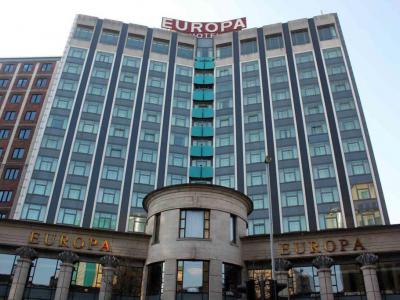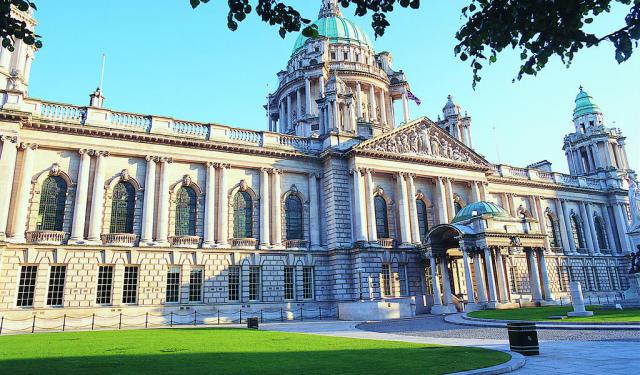Europa Hotel, Belfast
The Europa Hotel is one of Northern Ireland’s most iconic and enduring landmarks. Opened in 1971 atop the former Great Northern Railway station, it quickly earned a reputation as “the most bombed hotel in the world” after enduring around 33–36 bomb attacks during The Troubles. Despite its turbulent past, Europa remained open, serving as a lifeline for journalists, diplomats, and travellers, and standing as a powerful symbol of resilience.
Today, under the Hastings Hotels banner since 1993, the Europa has been beautifully restored and extended, boasting 272 contemporary rooms-92 of which are executive choices or suites-including the famed “Clinton Suite,” named after President Bill Clinton following his 1995 stay. Inside, the lavish marble-floored lobby leads to a lively piano lounge, a relaxed bar, and a bistro-style dining space. The emphasis on hospitality is palpable-from morning coffee and afternoon tea in elegant surrounds to cocktails and casual meals that showcase the best of Northern Ireland’s local produce.
Located steps from Belfast City Hall, the Grand Opera House, and the Linen Quarter, the Europa is a superb base for sightseeing, shopping, and cultural discovery. Guests can explore the nearby Titanic Quarter and Cathedral Quarter, and enjoy easy access to public transport at Great Victoria Street station. Whether you’re visiting for business, history, or leisure, the Europa Hotel offers a seamless blend of contemporary comfort and a rich, storied legacy-perfect for those seeking a uniquely Belfast experience.
Today, under the Hastings Hotels banner since 1993, the Europa has been beautifully restored and extended, boasting 272 contemporary rooms-92 of which are executive choices or suites-including the famed “Clinton Suite,” named after President Bill Clinton following his 1995 stay. Inside, the lavish marble-floored lobby leads to a lively piano lounge, a relaxed bar, and a bistro-style dining space. The emphasis on hospitality is palpable-from morning coffee and afternoon tea in elegant surrounds to cocktails and casual meals that showcase the best of Northern Ireland’s local produce.
Located steps from Belfast City Hall, the Grand Opera House, and the Linen Quarter, the Europa is a superb base for sightseeing, shopping, and cultural discovery. Guests can explore the nearby Titanic Quarter and Cathedral Quarter, and enjoy easy access to public transport at Great Victoria Street station. Whether you’re visiting for business, history, or leisure, the Europa Hotel offers a seamless blend of contemporary comfort and a rich, storied legacy-perfect for those seeking a uniquely Belfast experience.
Want to visit this sight? Check out these Self-Guided Walking Tours in Belfast. Alternatively, you can download the mobile app "GPSmyCity: Walks in 1K+ Cities" from Apple App Store or Google Play Store. The app turns your mobile device to a personal tour guide and it works offline, so no data plan is needed when traveling abroad.
Europa Hotel on Map
Sight Name: Europa Hotel
Sight Location: Belfast, Ireland (See walking tours in Belfast)
Sight Type: Attraction/Landmark
Sight Location: Belfast, Ireland (See walking tours in Belfast)
Sight Type: Attraction/Landmark
Walking Tours in Belfast, Ireland
Create Your Own Walk in Belfast
Creating your own self-guided walk in Belfast is easy and fun. Choose the city attractions that you want to see and a walk route map will be created just for you. You can even set your hotel as the start point of the walk.
Belfast Introduction Walking Tour
For over a century, the political situation of Belfast, the capital of Northern Ireland, has been the source of strife, first between the Crown-loyal Protestants and Irish Catholics, and more recently between the United Kingdom and the European Union.
Sitting on the banks of the River Lagan where it meets the Irish Sea, the city owes its name to this coastal condition, with "Belfast"... view more
Tour Duration: 2 Hour(s)
Travel Distance: 3.8 Km or 2.4 Miles
Sitting on the banks of the River Lagan where it meets the Irish Sea, the city owes its name to this coastal condition, with "Belfast"... view more
Tour Duration: 2 Hour(s)
Travel Distance: 3.8 Km or 2.4 Miles
Belfast Victorian Architecture Jewels
Described as “modestly scaled, undemonstrative, somewhat solid in aspect, and usually restrained (sometimes even austere) in its use of external decoration”, the urban landscape of Belfast has been influenced by the demands of shipbuilding and linen industry, much as transitioning between culture, arts, commerce, and education. Still, the architectural spectrum of the city is quite broad and... view more
Tour Duration: 2 Hour(s)
Travel Distance: 2.9 Km or 1.8 Miles
Tour Duration: 2 Hour(s)
Travel Distance: 2.9 Km or 1.8 Miles
The Troubles and Peace Process Landmarks
Decades past the official end of The Troubles in Belfast, the price of peace in Northern Ireland remains high. One of the means with which to secure it, back in 1969, was erecting a wall to physically separate the capital's warring Protestant and Catholic communities. Known since as the Peace Wall, the structure has become a popular tourist attraction for the multiple murals painted thereon... view more
Tour Duration: 1 Hour(s)
Travel Distance: 2.1 Km or 1.3 Miles
Tour Duration: 1 Hour(s)
Travel Distance: 2.1 Km or 1.3 Miles






